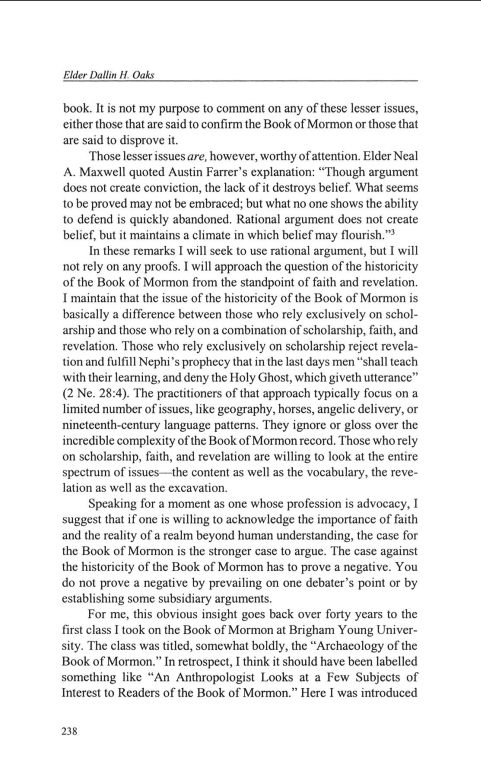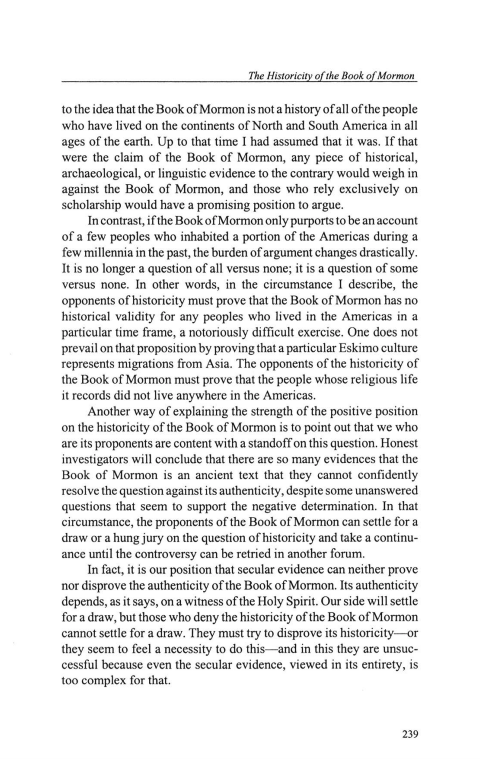Dallin H. Oaks says he learned to read the Book of Mormon in a limited geography context in the 1950s during his time as a student at BYU.
- Type
- Book
- Hearsay
- Scribed VerbatimDirectReprint
- Reference
Dallin H. Oaks, Speech, Annual Dinner of the Foundation for Ancient Research and Mormon Studies, October 29, 1993, rep. “The Historicity of the Book of Mormon,” in Historicity and the Latter-day Saint Scriptures, ed. Paul Y. Hoskisson. (Provo, UT: Religious Studies Center, Brigham Young University, 2001), 238–239
- Scribe/Publisher
- BYU Religious Studies Center
- Audience
- Reading Public
- Transcription
Speaking for a moment as one whose profession is advocacy, I suggest that if one is willing to acknowledge the importance of faith and the reality of a realm beyond human understanding, the case for the Book of Mormon is the stronger case to argue. The case against the historicity of the Book of Mormon has to prove a negative. You do not prove a negative by prevailing on one debater’s point or by establishing some subsidiary arguments.
For me, this obvious insight goes back over forty years to the first class I took on the Book of Mormon at Brigham Young University. The class was titled, somewhat boldly, the “Archaeology of the Book of Mormon.” In retrospect, I think it should have been labelled something like “An Anthropologist Looks at a Few Subjects of Interest to Readers of the Book of Mormon.” Here I was introduced to the idea that the Book of Mormon is not a history of all of the people who have lived on the continents of North and South America in all ages of the earth. Up to that time I had assumed that it was. If that were the claim of the Book of Mormon, any piece of historical, archaeological, or linguistic evidence to the contrary would weigh in against the Book of Mormon, and those who rely exclusively on scholarship would have a promising position to argue.
In contrast, if the Book of Mormon only purports to be an account of a few peoples who inhabited a portion of the Americas during a few millennia in the past, the burden of argument changes drastically. It is no longer a question of all versus none; it is a question of some versus none. In other words, in the circumstance I describe, the opponents of historicity must prove that the Book of Mormon has no historical validity for any peoples who lived in the Americas in a particular time frame, a notoriously difficult exercise. One does not prevail on that proposition by proving that a particular Eskimo culture represents migrations from Asia. The opponents of the historicity of the Book of Mormon must prove that the people whose religious life it records did not live anywhere in the Americas.
Another way of explaining the strength of the positive position on the historicity of the Book of Mormon is to point out that we who are its proponents are content with a standoff on this question. Honest investigators will conclude that there are so many evidences that the Book of Mormon is an ancient text that they cannot confidently resolve the question against its authenticity, despite some unanswered questions that seem to support the negative determination. In that circumstance, the proponents of the Book of Mormon can settle for a draw or a hung jury on the question of historicity and take a continuance until the controversy can be retried in another forum.
- Citations in Mormonr Qnas
The B. H. Roberts Foundation is not owned by, operated by, or affiliated with the Church of Jesus Christ of Latter-day Saints.


